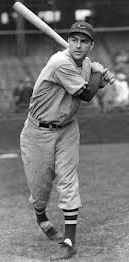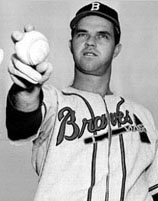|
Pivotal World Series Plays
Feller's Bad Luck
1948 World Series Game 1: Cleveland Indians @ Boston Braves
In October 1948, the United States was returned to the Indians. That was the line used by writers and broadcasters as the Boston Braves hosted the Cleveland Indians for Game 1 of the World Series.
There was no question of which pitcher Cleveland player-manager Lou Boudreau would start. Ace Bob Feller had started the previous Sunday in the 7-1 loss to Detroit in the last game of the season. That dropped the Indians into a first-place with the Boston Red Sox, necessitating the first playoff game in American League history. Southpaw Gene Bearden won his 20th game to beat the Sox 8-3 the next day at Fenway Park.
Since Feller had lasted only 2 1/3 innings in Game 154, Boudreau had no hesitation to start Rapid Robert in the Series opener Wednesday. In his ninth full season with the Indians - interrupted by four years in the navy in World War II - Feller had yet to appear in a World Series.
Boston manager Billy Southworth had two aces - righthander Johnny Sain (24-15, 2.50 ERA) and lefty Warren Spahn (15-12, 3.71). The saying that made the rounds during the stretch run was, "Spahn and Sain and pray for rain" although Bill Voiselle won 13 games and had a slightly better ERA (3.63) than Spahn, and Vern Bickford registered 11 victories with a 3.27 ERA. Both Spahn and Sain had started in the doubleheader the previous Saturday at the Polo Grounds. With the Braves' first NL pennant since 1914 clinched, Southworth pulled Sain after five innings to rest him for the Series opener.
    L-R: Lou Boudreau, Bob Feller, Johnny Sain, Billy Southworth Sain, featuring an outstanding curve, and fireballer Feller, who also threw a fine hook, were both sharp on a cool gray day in Beantown, and the game was scoreless heading into the bottom of the 8th. Sain had allowed four hits but no walks while Feller was even better–one hit and one walk. No runner on either team had reached third base.
The fateful half-inning began with C Bill Salkeld drawing a base on balls while most of the fans in the crowd of 40,135 began the rhythmic rally applause. Phil Masi, also a catcher but faster afoot, ran for Salkeld. Knowing one run was likely to win the game, Southworth gave the bunt sign to one of his best hitters, Mike McCormick (.303 with a team-leading 23 home runs). That advanced Masi to second with one out.
Now Boudreau made a crucial decision - walk the eight-hole hitter Eddie Stanky. Utility infielder Sibby Sisti ran for Stanky. That brought up Sain, one of the better hitting pitchers (.217 that year after .346 in '47). He nearly crossed up the Indians when he got wood on the ball and lined to RF Wally Judnich, who hustled back to grab the ball.
Sportswriters from around the country covering the Series debated the wisdom of walking Stanky intentionally. Those favoring the move said it brought up the pitcher with the chance for a double play to end the inning. Those criticizing the move gave several reasons. First, Feller tended to give up fly balls more than grounders. Secondly, Stanky had suffered a broken ankle in July and had played in only six games since returning to action.
Up stepped RF Tommy Holmes, the Braves' leadoff batter. Mel Allen, announcing the game nationally for NBC radio, called it "Bobby's biggest task of the ball game." Before delivering a pitch to Holmes, Feller whirled from his stretch position on the rubber and fired the ball to Boudreau who put the tag on the diving Masi. Umpire Bill Stewart called the runner safe, provoking an argument from the Cleveland skipper. Allen told his audience, "Bill Stewart signals that he tagged him on the arm about the elbow, meaning, of course, that the hand had the bag before Boudreau put on the tag." Then Mel explained that "the Indians have a great pickoff play. ... When the sign is put on, a count is started by Bobby Feller and Boudreau. Then Lou will break for the bag, and Bob will swing around and throw."
 One of the first uses of photography to dispute an umpire's call. The second frame seems to show Boudreau applying the tag before Masi's hand reaches the bag. Boudreau said after the game, "I'm sure that Masi was out. Stewart is a National League umpire, and he is not acquainted with our pick-off play. I don't think he was in a good position to see the tag. I know I got him. I tagged him on his shoulder. But that's just my opinion. Stewart had his. It isn't a complaint."
The Indians successfully pulled the pickoff play at second base the next day in the first inning. P Bob Lemon whirled and threw to Boudreau to nail Earl Torgeson.
With the count one-and-one, Holmes hit a blooper down the third base line. Masi took his cap off and raced around third bareheaded to score the game's first run. When LF Dale Mitchell threw vainly to the plate, Sisti continued to third, and Holmes took second.
With a chance to break open the game, SS Alvin Dark grounded out third-to-first.
Sain set down the first two batters in the top of the ninth. Then Ken Keltner reached second when his counterpart at third base, Bob Elliott, threw wild to first. But Judnich took a third strike to end the game. Final score: Braves 1 Indians 0
Feller got another start in Game 5 the following Sunday. Since the Indians won Games 2, 3, and 4, a World Series record crowd of 86,288 overflowed Cleveland Municipal Stadium to see their favorite hurler clinch the Series. But it was not to be. The Braves scored three in the first and led 4-1 after three. The Indians moved in front with four in the bottom of the fourth. But Feller couldn't hold the lead. He was relieved during the visitors six-run seventh. His line read 6 1/2 innings, 8 hits, 7 R/ER, 2 BB, 5 K, and 3 HR. The Braves' 11-5 triumph sent the Series back to Boston where the Indians won the Series behind Gene Brearden in Game 6, 4-3.
By the time the Indians made the World Series again in 1954, Feller was 35 years old and the fifth starter in an outstanding rotation that featured Early Wynn, Mike Garcia, and Bob Lemon. Bob never threw a pitch in the four-game sweep by the New York Giants.
Feller retired after the '56 season with 266 victories. He would undoubtedly have reached the magic 300 mark had World War II not interrupted his career. He was inducted into the Hall of Fame in 1962, appearing on 150 of the 160 ballots. He is rightly revered as one of the greatest pitchers in baseball history. But he never experienced the joy of a World Series victory.
|